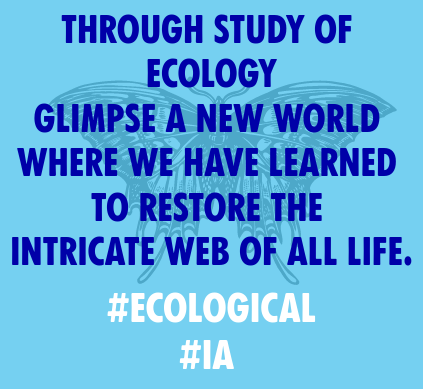6 Ecological ideas for your IA
 There has never been a time with so much environmental activism, #ClimateStrikeOnline, Extinction Rebellion, Greenpeace, Ecosia, Friends of the Earth, COP, CITES, and so many more projects that are too numerous to mention. The rise of activity is in no small part a reaction to the increasing environmental damage we can see in our world. Many people old and young, especially young want to make a difference, however small, to improve the world and show people that there is another way.
There has never been a time with so much environmental activism, #ClimateStrikeOnline, Extinction Rebellion, Greenpeace, Ecosia, Friends of the Earth, COP, CITES, and so many more projects that are too numerous to mention. The rise of activity is in no small part a reaction to the increasing environmental damage we can see in our world. Many people old and young, especially young want to make a difference, however small, to improve the world and show people that there is another way.
IA - Investigation ideas
The Individual investigation could be an opening to demonstrate the foolishness of our actions, the simplicity of potential solutions or correlations between causes of ecological damages and their effects. Anyone who cares about conservation of biodiversity, protecting animals from extinction, the Impending world food crisis could further their understanding by completing an IA about one of these global issues. Others might seek solutions to local problems as so much of global action is rooted in the local environment.
Whatever the choice, remember that the Biology IA is a short study and that only one variable can be manipulated in the IA.
The effect of an abiotic factor on a single feature of leaf structure
This is an interesting opportunity to investigate form and function in the leaves of plants. There are several features of plant leaves which are easy to see with the naked eye, such as shape and colour. Other features require some kind of measuring tool, for example a colorimeter for pigment composition, or for measuring thickness. There are also features which may be interesting to study with a microscope for example, stomata density, the shape of palisade mesophyll cells, the presence or absence of hairs, or the density of hairs on different parts of the leaf might be interesting. Abiotic factors could be identified and the sites of leaf sampling could be carefully chosen to incorporate control of variables. While this might be difficult there is a lot which can be considered such as amount of water in the soil, light levels, wind speed, etc.
The effect of aphids on a single aspect of plant structure.
Beans and roses grown in a garden often suffer from the presence of aphids. In my garden the aphids are sometimes actually cultivated by ants. Does this herbivory affect any structures on the plant leaves. Do the leaves respond to the presence of the aphids? For example could there be an increase in the thickness of epithelial cells in the leaf, could there be an increase in the density of hairs on the veins of the leaf, alternatively could the presence of leaf hairs on the veins affect the distribution of aphids on the leaves? There are plenty of options in this kind of study but it could only be carried out during the summer / autumn season when leaves have had time to respond.
The effects of aquatic plants on the nitrate content of water.
We know that plants take up nitrates from their roots by diffusion or active transport and that ecological swimming pools can be constructed using plants and gravel instead of filters. However, in high nitrate water the algae can bloom and cause eutrophication. Would other plants cause eutrophication at high nitrate levels, or is it the fact the algae reduce light penetration in the water and thus lead to the death of some of the algae and the growth of bacteria which causes eutrophication? This topic is a rich source of research questions and it is quite easy to test the nitrate (and other ion) content of water. What about experimenting with lettuce plants in a hydroponics system or in a school aquarium?
Do migratory birds carry diseases to farm animals?
In many countries the occurrence of diseases in farm animals or fisheries is recorded by a national agricultural service. At the same time there are possible causes of the spread of disease, or animal susceptibility to infections. For example, migratory birds could spread disease to free range chicken farms. In this type of study it is important to be selective about the data and to try to control other variables, for example the size of farms, the breed of animals, etc.
Is there evidence of changes in climate could cause changes in agricultural yields?
This could be a study of climate data and harvesting dates in different years, or it could be a consideration of long term trends in harvesting dates. Temperature or rainfall could affect the onset of flowering the size of fruit or the quality of grapes or wine. Climate data, or geographical location of different farms could be used to test for correlations. Industry data is usually recorded in data bases of annual production of food types.
Do conditions of animal husbandry affect the frequency of disease in farm animals?
From time to time there are outbreaks of disease in domestic animals in farms around the world. Foot and mouth disease is one example. Are there any factors of animal husbandry which could increase the risk of outbreaks of such diseases? Data about disease outbreaks is available online and also information about agricultural methods in different countries, or regions. There are other environmental factors linked to regulations and control of hygiene at farmers' markets, or abattoirs.

 IB Docs (2) Team
IB Docs (2) Team
